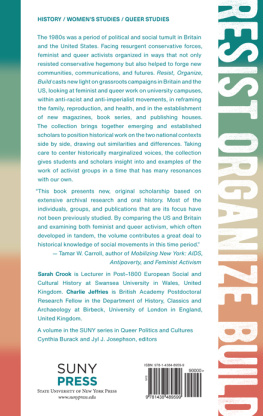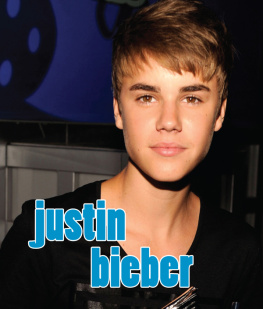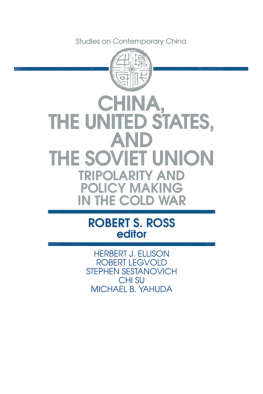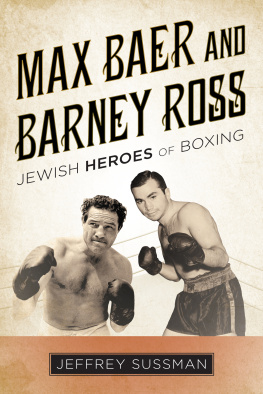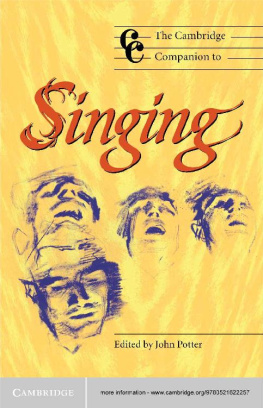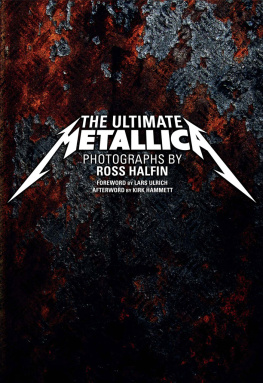
HBI SERIES ON JEWISH WOMEN
Shulamit Reinharz, General Editor
Sylvia Barack Fishman, Associate Editor
The HBI Series on Jewish Women, created by the Hadassah-Brandeis Institute, publishes a wide range of books by and about Jewish women in diverse contexts and time periods. Of interest to scholars and the educated public, the HBI Series on Jewish Women fills major gaps in Jewish Studies and in Women and Gender Studies as well as their intersection.
The HBI Series on Jewish Women is supported by a generous gift from Dr. Laura S. Schor.
For the complete list of books that are available in this series, please see www.upne.com
Sarah M. Ross, A Season of Singing: Creating Feminist Jewish Music in the United States
Margalit Shilo, Girls of Liberty: The Struggle for Suffrage in Mandatory Palestine
Sylvia Barack Fishman, editor, Love, Marriage, and Jewish Families: Paradoxes of a Social Revolution
Cynthia Kaplan Shamash, The Strangers We Became: Lessons in Exile from One of Iraqs Last Jews
Marcia Falk, The Days Between: Blessings, Poems, and Directions of the Heart for the Jewish High Holiday Season
Inbar Raveh, Feminist Rereadings of Rabbinic Literature
Laura Silver, The Book of Knish: In Search of the Jewish Soul Food
Sharon R. Siegel, A Jewish Ceremony for Newborn Girls: The Torahs Covenant Affirmed
Laura S. Schor, The Best School in Jerusalem: Annie Landaus School for Girls, 19001960
Federica K. Clementi, Holocaust Mothers and Daughters: Family, History, and Trauma
Elana Maryles Sztokman and Chaya Rosenfeld Gorsetman, Educating in the Divine Image: Gender Issues in Orthodox Jewish Day Schools
Ilana Szobel, A Poetics of Trauma: The Work of Dahlia Ravikovitch
Susan M. Weiss and Netty C. Gross-Horowitz, Marriage and Divorce in the Jewish State: Israels Civil War
Ronit Irshai, Fertility and Jewish Law: Feminist Perspectives on Orthodox Responsa Literature
Elana Maryles Sztokman, The Mens Section: Orthodox Jewish Men in an Egalitarian World
Sharon Faye Koren, Forsaken: The Menstruant in Medieval Jewish Mysticism
A SEASON OF Singing
 | Creating Feminist Jewish Music in the United States |
SARAH M. ROSS
BRANDEIS UNIVERSITY PRESS
Waltham, Massachusetts
Brandeis University Press
An imprint of University Press of New England
www.upne.com
2016 Brandeis University
All rights reserved
For permission to reproduce any of the material in this book, contact Permissions, University Press of New England, One Court Street, Suite 250, Lebanon NH 03766; or visit www.upne.com
This book was published through the generosity of the Laura S. Schor fund.
Hadlakat Neyrot Shabbat and Lkhu, Reyot Vreyim from Marcia Falk, The Book of Blessings: New Jewish Prayers for Daily Life, the Sabbath, and the New Moon Festival (HarperSanFrancisco, 1996). Copyright 1996 by Marcia Lee Falk. Used by permission of the author.
Library of Congress Cataloging-in-Publication Data
Names: Ross, Sarah M.
Title: A season of singing: creating feminist Jewish music in the United States / Sarah M. Ross.
Description: Waltham, Massachusetts : Brandeis University Press, [2016] | Series: HBI series on Jewish women | Includes bibliographical references and index.
Identifiers: LCCN 2016008178 (print) | LCCN 2016015771 (ebook) | ISBN 9781611689594 (cloth: alk. paper) | ISBN 9781611689600 (pbk.: alk. paper) | ISBN 9781611689617 (epub, mobi & pdf)
Subjects: LCSH : JewsUnited StatesMusicHistory and criticism | Feminist musicUnited StatesHistory and criticism. | Women in JudaismUnited States.
Classification: LCC ML 3776 .R67 2016 (print) | LCC ML 3776 (ebook) | DDC 782.42082/0973dc23
LC record available at https://lccn.loc.gov/2016008178
CONTENTS
FOREWORD
A Season of Singing: Creating Feminist Jewish Music in the United States is the fifty-second volume in the HBI Series on Jewish Women and the first in the series to deal with music. That it is the first suggests that studies of Jews, gender, and music are few and far between, although musicparticularly singingis an important aspect of Jewish life all over the world, ranging from singing in summer camp to singing at the Friday night Shabbat table, and more.
As Sarah Ross informs us, from the 1960s and into the twenty-first century, a feminist Jewish music scene developed in the United States, specifically in the Conservative, Reform, Jewish Renewal, and Reconstructionist communities, but also in some Orthodox venues such as the synagogue Shira Hadasha (literally a new song) in Jerusalem. She calls the individuals who led this music scene singer-songwriters, meaning that they both composed and performed/led/taught their songs.
As Ross states correctly, feminist Jewish music is both a musical genre and a sociopolitical phenomenon, a model designed to change conventional ideas and open up new possibilities. We have seen peoples turn to participatory singing in many countries, including Cuba and South Africa, as a way of protesting against the status quo. Folk music promoting peace was an element in the American publics effort to end the Vietnam War. Folk music in Israel has focused on celebrating the land and escaping from the jaws of military defeat. Ross puts it this way: Immediately accessible and emotionally compelling, music helps people forge a community music has the potential to have a public voice and to imagine alternative ways of thinking.
But music is not only about change. In fact, feminist Jewish singer-songwriters strove to balance the preservation of Jewish tradition while advocating change. Perhaps that is why this music has been accepted enthusiastically in many circles and adopted to such an extent that some Jews think this music was always there.
In Rosss introductory chapter, she accounts for the emergence of this music by exploring a wide variety of subjects including feminist theology (Judith Plaskows writings, for example) and feminist writing about Judaism in general; the American counterculture; changes within the denominations; the Six-Day War; relations to African Americans; the havurah movement; the American folk music revival; and the embrace of a range of sexualities. Jewish women did more than challenge and revise Halakhah (religious law); rather, they attempted to make Judaism more spiritually enriching. Music played a large role in this move. Feminist Judaism also embraced ritual innovation, such as putting an orange on the seder plate, ordaining women as rabbis and cantors, tackling the Agunah problem (womens inability to obtain divorce from recalcitrant husbands), open prayer at the kotel (the Wailing Wall), and much more. New rituals created a need for new music to accompany them.
Jewish feminist singer-songwriters, according to Sarah Ross, were also inspired by emergent female folk singers such as Joan Baez, Holly Near, Mary Travers (of Peter, Paul and Mary), and others. As singer-songwriter Meg Christian defined womens music of the time, it is music that honors women, that respects our strength, celebrates our lives, supports and validates us, and teaches us. Although Jewish women could be inspired by secular womens music, Jewish women had a special challenge stemming from the concept of Kol Isha , a rabbinic prohibition against womens voices being heard in public prayer. Even if this idea is irrelevant in non-Orthodox Jewish settings, it still creates a damper on womens vocal expression more generally.





